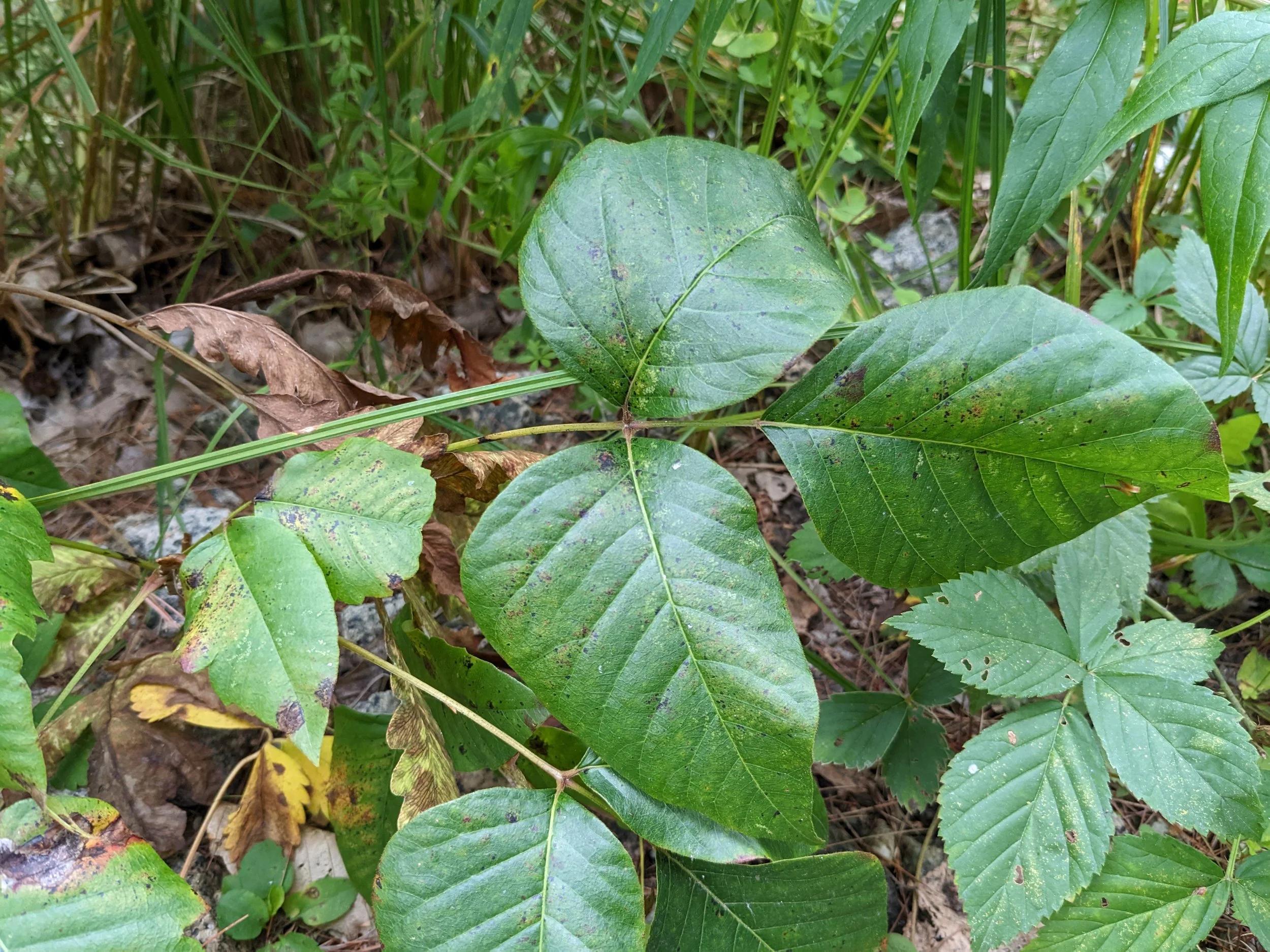The Many Identities of Poison Ivy, Toxicodendren radicans
by Debra Marnich, CLC Stewardship Director
Smooth-edge-leafed poison ivy. All photos: Debra Marnich. Click any image for a larger view.
Spring is the perfect time to talk about poison ivy, Toxicodendren radicans.
Poison ivy (PI) is a native plant of the United States and Canada found on the edges of roadsides, forests, and fields, in floodplains along rivers, and even in open fields. The plant is found throughout New Hampshire, and as mean temperatures rise in the region and land is increasingly disturbed, it moves northward and becomes more abundant.
At a closer glance—not too close!—the PI plant can be a master of disguise, appearing in different forms, shapes, and colors. Proper identification of the plant, in all stages, seasons, and on all sites, is necessary.
Lobed-edge-leafed PI.
PI in the autumn.
PI vine climbing a tree.
Have you heard the phrase, “Leaves of three, let it be”? The leaves of the PI plant are in clusters of three, arranged alternately on the stem; the stem of the center leaf is longest. In spring, leaves emerge red or light green in color. As the season progresses, the leaves can be shiny or dull, usually dark green in color. In fall, the leaves may turn red, orange, or yellow. Leaf edges may be lobed or smooth. The berries are green in spring, then turn a waxy tan in the fall.
PI can adopt multiple forms of growth depending on the site location. Three are typical: plant, shrub, and vine. The plant form of PI is usually found growing low to the ground—one to two feet high—often in the understory of a forest, whereas the shrub form can grow to five or six feet in a sunny site in the mid-story. The vine of PI grows thick around the trunks of trees and is covered in tiny hairs, giving it an overall fuzzy or hairy appearance. These hairs are the plant’s aerial rootlets and they are also poisonous at all times of the year.
Sarsaparilla.
Virginia creeper.
River grapevine.
Bittersweet vine.
Many plants in New England are PI look-alikes, such as wild sarsaparilla, Aralia nudicaulis and poison sumac, Toxicodendron vernix (also very toxic—avoid!). Vines that grow in New England such as Virginia creeper, Parthenocissus quinquefolia; Asiatic bittersweet, Celastrus orbiculatus; and wild grape vines, Vitis labrusca or Vitis riparia, may sometimes be mistaken for PI.
The toxin urushiol is found in the roots, leaves, vines, and stems of PI plants. Urushiol is the same toxin found in poison oak and poison sumac. Humans and a few other primates are the only species that are affected by urushiol oil. In fact, PI is an important source of food for most wildlife. Many mammals, birds, amphibians, and insects eat the plant and use it as shelter. Pollinators visit PI flowers. Common wildlife species from black bears to cedar waxwings and squirrels feed on the white berries that emerge in the fall. Many resident birds rely on PI berries long into the cooler season when most other plants have lost their leaves and berries. Crows and wild turkeys are known to feed on PI berries in the winter. Deer, black bears, and raccoons all use the leaves as a food source. The vines create vertical diversity in the forest structure that mice and frogs and toads can use for shelter and as a thruway to climb trees.
If you find you have an allergic reaction to urushiol (not all people do), there are safe, non-chemical ways to remove PI. Before experimenting with any of these methods, be sure to wear protective attire: a long shirt and pants, disposable gloves, and protective eye equipment. Urushiol will remain on clothing, boots, tools, and dogs until they are washed properly, and can be transferred to humans that way. You can dig the entire plant and roots up, pour boiling water over the plant with a tea kettle, smother it with a heavy piece of cardboard (weighted down), use a salt/soap and water spray, spray white vinegar on the plant, cut it back and repeat, or let a goat or sheep do the work for you. Yes, goats and sheep will eat poison ivy.
Please note: burning PI in a fire is never a recommended form of removal, as the smoke from the fire contains urushiol and can affect your lungs. Composting PI is also not recommended: urushiol oil is very slow to degrade.
Spotted Touch-me-not.
A natural remedy for PI is Spotted Touch-me-not—or jewelweed—Impatiens capensis, which often grows in the same areas as PI. The juice of the leaves and stems of jewelweed seems to nullify the effect of the oil and can prevent rash. Also, most pharmacies carry preventive over-the-counter blockers that create a barrier on your skin to protect from poison ivy, oak, and sumac. Those who are highly allergic can investigate lowering sensitivity with homeopathic treatment starting in the winter before the plants emerge.
Banner image: Poison ivy! Photo: Debra Marnich

